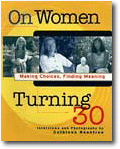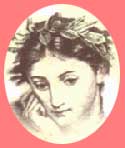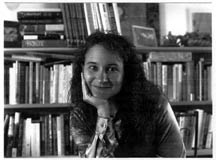|
Excerpt: On Women Turning 30:
Making Choices/Finding Meaning
Introduction
What I found during the course of interviewing a variety of women
in their thirties and writing this book is that the thirties is
a highly performance-oriented, pressure-packed decade. This is not
a decade of leisure. In conversation with Susie Bright, the outspoken
author of “The Sexual State of the Union” and her newest
book on creating a sexual philosophy for yourself, called “Full
Exposure,” she told me: By the time a woman is in her thirties,
“It’s finally okay to be sexual. We were told not to have
sex in high school, not to have sex in college, but now it’s
‘Hey, aren’t you married yet!?’” Women in their
thirties are supposed to have put it all together: marriage, children,
and, of course, a successful career. It is assumed that they launched
their career in their twenties.
Susie asked the question: “When did this all happen? When
did the thirties become such a pressure-filled time? It used to
be that after thirty women were getting their first divorce, already
had kids, and were entering their forties with their kids grown
up and leaving home. Think about how much things have changed in
the past few decades: it seems like everyone is supposed to be,
or allowed to be, immature longer. Teenagers are treated like babies;
twenty year olds are treated like teenagers; and yet, when you reach
your thirties, you’re suddenly supposed to be a super adult,
super woman. There are all these expectations. Women feel that they
have to squeeze in ambition between childhood and motherhood. It’s
relentless.”
Using Naomi Wolf’s definition of feminism: “Women’s
ability to think about their subjugated role in history, and then
to do something about it,” all the women interviewed for this
book have an awareness of what they owe to the feminist movement
and consider themselves feminists.
Who are women in their thirties? Unlike the decade of the forties
and beyond, women in their thirties usually have not had the time
necessary to make a name in their chosen field. Many of those who
have, such as Camryn Manheim, Jodi Foster, Natasia Richardson, Alfre
Woodard, Marisa Tomei, Mira Sorvino, Janet Jackson, Lili Taylor,
Courtney Love, Emme, Calista Flockhart, Sarah McClaughlin, Jennifer
Jason Leigh, Laura Dern, Brigid Fonda, Joan Chen, Emily Watson,
Mariel Hemingway, Molly Ringwald, and Diva Cecilia Bartoli, are
all in the arts and entertainment industry and have achieved celebrity
status. Noted authors in their thirties are feminist-spokeswoman,
Susan Faludi, Elizabeth Wurtzel, author of the best-selling “Prozac
Nation” and “Bitch,” Helen Fielding (author of the
best-selling novel about a thirty-something single woman, “Bridget
Jones’s Diary”), and Julia Alvarez.
Other women, who are not well-known, but, undoubtedly, will be
in the future, because they are all pioneers pushing back frontiers
of inquiry, technology and gender, are: the Chicago-based sexual
harassment and discrimination attorneys Mary Stowell and Linda Friedman,
who filed a class-action sex discrimination suit on behalf of twenty-three
women against the brokerage house of Salomon Smith Barney -- the
second largest firm in the nation; the project manager, scientist,
and engineer for the planetary exploration of Mars at the National
Aeronautics and Space Administration, Sarah A. Gavit, Suzanne E.
Smrekar, and Kari A. Lewis -- all but Lewis, who is twenty-five,
are in their thirties; Margaret Edson wrote her play “Wit”
-- a story about the life and death of a John Donne scholar -- when
she was only thirty, it took her seven years to get it produced,
but when she did, it was on Broadway and it received a Pulitzer
Prize; Heather Mills was a British model until she lost her left
leg in a pedestrian accident, one year later she founded the Heather
Mills Health Trust to recycle artificial limbs to amputees from
Croatia to Cambodia, she managed with extraordinary resilience to
turn her misfortune into a powerful vehicle for helping others;
Michelle Banks, a deaf African American actress, is the founder
and Artistic Director of Onyx Theatre Company in Washington, D.C.,
the first deaf theatre company for People of Color in the United
States; Michela Alioto, a charismatic young woman in her early thirties,
has decided to follow in the footsteps of her high-profile political
family pursue a life in politics. This in itself is not unusual,
but the fact that Michela has been wheelchair-bound since a ski-lift
accident when she was seventeen left her paralized from the waist
down is; and Patricia Buttenheim and Ann Snoeyenbos, a nurse and
reference librarian, respectively, from Manhattan, are ultra athletes
who competed in the Double Ironman race (that’s 4.8 miles of
swimming, 224 miles of biking and 52.4 miles of running -- and these
are consecutive events. The women’s record, set in 1994, is
22 hours, 7 minutes.).
And who are the women you will encounter and be inspired by in
this book? As mentioned earlier, some of the current trends for
women in their thirties in the new millennium are that women in
their thirties have postponed having children in their twenties.
Of the sixteen women included here, twelve do not yet have children.
Women are observing serial monogamy and/or marrying later than in
past decades: of the sixteen women included here, eleven are unmarried.
Having come of age after the sexual revolution of the 1960’s,
women are experiencing more freedom in sexual orientation. Four
of the women in this book consider themselves either lesbian or
bisexual. If a desire for children precedes the actualization of
a committed relationship or marriage, women are opting for single
parenthood or, in the case of some lesbian mothers, opting for the
choice of a two-mother family, rather than the traditional father-as-head-of
nuclear family. One woman among the sixteen became pregnant as a
single woman and made the choice to raise her child on her own;
and another woman is helping to raise her female partner’s
child.
All but two of the women have satisfying, full-time careers that
they have chosen and are financially self-supporting. There are
six women of color. Their careers range from an academic scholar,
Randi Gray Kristensen; teacher, Susana Herrera and Kate Noonan;
performance artist and theatre director, Kate Noonan; anthropologist,
Katherine Spilde; chef and mother, Mima Lecocq; writer and mother,
Susie Bright; writer, Susana Herrera and Ikazo; mother and student,
Char Wolf; social activist, Rebecca Walker and Kamala Deosaransingh;
documentary filmmaker, Lisa Leeman; psychotherapist, Francesca Farentelli;
visual and environmental artist, Monica Praba Pilar; environmental
activist, Nell Newman; professional athlete and trainer, Terry Schneider;
and medical doctor and psychiatrist, Elisabeth Targ.
Women who are currently in their thirties are the first post-baby
boom generation and the first generation to fully benefit from the
second wave of the Women’s Movement which began with the publication
of Betty Friedan’s “The Feminine Mystique” published
in 1963. There is a range of women in their thirties: those who
are single and love it and are ensconced in a rewarding career/profession;
those who are trying to do it all: marriage, children and career;
those who are married with three kids and have no professional life;
those who are terrified that they will never marry and have children;
those who choose to bear and raise or adopt children as single mothers;
and women who have deliberately chosen a lesbian or bisexual lifestyle.
As always class and geography still affect a woman’s place
in the world. “In Minnesota,” according to Katherine Spilde,
a participant in this book, who was born and raised in Minnesota,
“it may still be significant if a woman is unmarried by her
thirties, whereas in California or New York City [both areas in
which Katherine has also lived], the emphasis is not the same.”
In general, women in the middle-class and upwards take for granted
that they will attend college. If they don’t, it is usually
related to the class/economic system, rather than to gender bias
as it was in the past.
Even though there have been structural changes in terms of women’s
rights during the past thirty-five years:
Title 9, which allows women to play professional sports
The supposed shattering of the glass ceiling
The Anita Hill/Clarence Thomas case, which brought attention to
the issue of sexual harassment in the work force
It takes time for these new awarenesses to reach society in general.
There is a lagtime in catching up to new freedoms. While there
may have been political emancipation, the backlash against women
has taken a more subtle turn in symptoms such as an increase in
eating disorders. As the old structures fall, are women now taking
the lead in holding themselves back by internalizing a patriarchal
prejudice? Two of the women I interviewed for this book speak at
length about eating disorders -- Katherine Spilde of her own difficulties
with anorexia, bulemia, and weight gain and loss; and Francesca
Farentelli of her experience as an eating disorder therapist. What
have been the stereotypes about women in the decade of their thirties?
The thirties is a decade of childbearing. If a woman isn’t
married yet, she’s on her way to spinsterhood Women should
be settled in a career.
The thirties is the decade of “serious” (leading to marriage)
dating The biological time clock is ticking and women feel a desperation
to have a traditional marriage before they can bring children into
the world.
What I have found to be the current trends about women in their
thirties in the new millennium are that women in their thirties
have postponed having children in their twenties; they may be exploring
several careers before settling on one; in an era of AIDS and safe-sex
consciousness, women are observing serial monogamy and/or marrying
later than in past decades; having come of age after the sexual
revolution of the 1960’s, women are experiencing more freedom
in sexual orientation; if a desire for children precedes the actualization
of a committed relationship or marriage, women are opting for single
parenthood or, in the case of some lesbian mothers, opting for the
choice of a two-mother family, rather than the traditional father-as-head-of
nuclear family.
How has the decade of a woman’s thirties changed for women
over the years? I gave birth to my only child when I was twenty
years old in 1969, went back to undergrad school in my mid-twenties
and graduate school in my late-forties, and opened a restaurant
at thirty. By the time I was forty, my son was half-way through
college, and I had been married and divorced and had three other
long-term relationships. Most of the women in this book remain unmarried
and childless. Some by choice, some in the process of trying to
conceive, some hoping for the magical remedy of the “right
man” or relationship to answer their dilemma, some resigned,
willingly or otherwise, to never having children.
I saw how tense many women in their late-thirties are about “getting
their life together.” Some of those who are not in relationship
with a man feel a desperation as their biological clock ticks away
“like a New York taxi meter,” as Francesca Farentelli
put it. Curiously, it used to be the forties, a time when women’s
looks begin to noticeably change, that this desperation set in,
but now the big question for women in their thirties is: why aren’t
you married, why aren’t you fit, why aren’t you pregnant,
why aren’t you producing: kids, work, career, etc.?
Many women are taking this question of children to a new level.
Examples of well-known women who have chosen to have children on
their own as single mothers are: Jodi Foster, Diane Keaton (in her
50s), Sinead O’Connor, Linn Ullmann (daughter of Liv Ullmann
and Ingmar Bergman), and, of course, the most public of all single
mothers, Madonna, who contributed to the debate on “family
values” that both major American political parties have addressed.
One of the major changes to have marked the second half of the
twentieth century has probably been the erosion, for better or worse,
of the nuclear family unit. In 1950, only four percent of American
babies were born to mothers who were not married, and the stigma
of birth out of wedlock was so great that many of them were placed
for adoption. Now, according to Melissa Ludtke, in her book “On
Our Own: Unmarried Motherhood in America,” almost a third --
more than a million a year -- are born to unmarried women, a change
that has sparked bitter national debate over everything from sex
roles to welfare reform. As a means for art to answer this question,
in the 1999 novel by Elizabeth Berg “Talk Before Sleep,”
the thirty-six-year-old protagonist is Patty Anne Murphy, a real
estate agent, who is single and wants a baby more than anything.
Her solution? Convince her gay best friend, Ethan Allen Gaines,
who has also struck out trying to find a partner, to give parenthood
a shot together. They do. Recently a friend sent me a quote from
a July 29, 1999 newspaper article in “USA Today.” The
article was about Lifetime television and their new executives.
It quoted Gloria Steinem as saying: "Lifetime is very valuable.
It celebrates women’s power. For their profiles, viewers would
be quite interested in women who are not famous. There should be
more profiles on interesting , worthwhile women who are not famous."
Most of the women I have chosen to include in this book are “interesting,
worthwhile women who are not famous.” All of them are interesting
because they are passionately living their lives, fully engaged.
They are all worthwhile because, no matter what your age as the
reader, each woman will inspire you with her energy, enthusiasm,
and commitment. The women in this book, each in her own way, are
making choices and finding meaning.
copyright ©2000 by Cathleen Rountree

On Women Turning 30:
Making Choices, Finding Meaning
Interviews and Photography
by Cathleen Rountree
Order either through your local bookseller or 
Click this link to order from Amazon.com.
Cathleen will be happy to sign self-adhesive personalized signature labels for as many books as you purchase or already own. Email Cathleen your requests at Cathleen@CathleenRountree.com (along with your address) and she'll send the signed bookplate, which may be applied to the title page.
|






